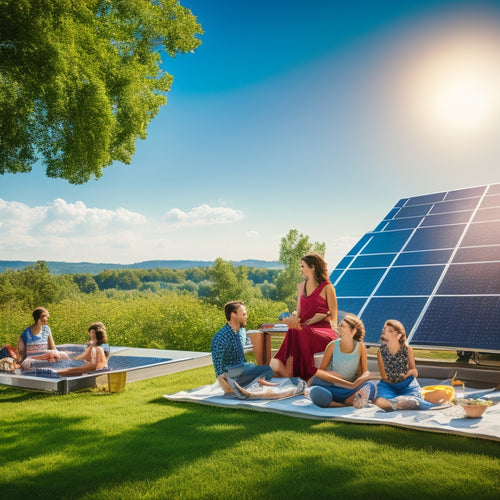
7 Essential Steps for Solar Panel Installation in Businesses
Share
When installing solar panels in your business, you'll want to follow seven essential steps to guarantee a successful shift to renewable energy. Start by conducting a site assessment and analysis to evaluate your solar potential and energy consumption patterns. Next, design a solar panel system layout that maximizes energy production and meets local regulations. Obtain necessary permits and approvals, then install a secure mounting system that withstands environmental stressors. Connect your solar panels and inverters, optimizing energy transfer and power output. Thoroughly test and commission the system, verifying its performance and safety. Finally, monitor and maintain your system's performance to maximize energy output and extend its lifespan - and that's just the beginning of your expedition to utilizing the full potential of solar energy for your business.
Key Takeaways
- Assess the business's energy consumption patterns to determine the ideal system size and layout for maximum energy production.
- Ensure compliance with local building codes, regulations, and permits to avoid fines and installation delays.
- Choose the right mounting technique and equipment to withstand environmental stressors and ensure structural integrity.
- Conduct thorough testing and commissioning to verify system performance, identify potential issues, and optimize energy output.
- Regularly monitor and maintain the system to maximize energy production, reduce downtime, and extend system lifespan.
Conducting Site Assessment and Analysis
Evaluating your site's suitability for solar panels is an important step in the installation process. You need to determine your solar potential, which involves evaluating your roof's orientation and performing a shading analysis to identify any obstacles that could reduce energy production.
Additionally, you must verify your roof's structural integrity can support the weight of the solar panels.
You'll also want to analyze your energy consumption patterns to determine the ideal system size. It's vital to research local regulations and permits required for solar panel installation in your area.
Moreover, consider the environmental impact and potential financial incentives, such as tax credits or rebates, that can offset the installation costs.
A thorough site assessment and analysis will provide significant perspectives, enabling you to make informed decisions about your solar panel installation.
Designing Solar Panel System Layout
Once you've completed the site evaluation and analysis, you can begin designing your solar panel system layout. This involves determining the ideal solar panel orientation, performing a shading analysis, and evaluating your energy consumption patterns. Your goal is to maximize energy production while minimizing costs.
| Design Considerations | Key Factors |
|---|---|
| System Capacity | Energy consumption, financial incentives |
| Equipment Selection | Installation timeline, maintenance schedule |
| Grid Connection | Grid connection type, system scalability |
| Environmental Impact | Shading analysis, environmental impact |
When designing your solar panel system layout, consider the following key factors: system capacity, equipment selection, grid connection, and environmental impact. Make sure that your system is scalable and can be easily expanded or modified in the future. By carefully planning your solar panel system layout, you can maximize your energy savings, reduce your environmental impact, and enjoy a strong return on investment.
Obtaining Necessary Permits and Approvals
Before you can start installing your solar panel system, you'll need to secure the necessary permits and approvals from your local government and utility company.
This vital step guarantees your business complies with regulatory requirements and local guidelines, avoiding potential setbacks or fines.
To manage the permit process, consider the following:
-
Review local building codes and ordinances: Familiarize yourself with local regulations governing solar panel installations, including electrical and fire safety standards.
-
Submit applications to relevant authorities: Prepare and submit applications to your local government and utility company, providing detailed plans and specifications for your solar panel system.
-
Address environmental considerations: Confirm your installation meets environmental standards, such as avoiding sensitive ecosystems or protected wildlife habitats.
- Track and respond to application status: Monitor the progress of your applications and respond promptly to any requests for additional information or clarification.
Installing Solar Panel Mounting System
With your permits and approvals in hand, you're now ready to begin the installation process by setting up the solar panel mounting system. This critical step guarantees your solar panels are securely fastened to your building's roof or ground, assuring peak energy production and longevity.
You'll need to choose the right mounting technique, considering factors like roof type, size, and material. Common mounting techniques include:
| Mounting Technique | Roof Type | Structural Integrity |
|---|---|---|
| Rail-based mounting | Asphalt shingles, metal, or tile | High strength, adjustable |
| Ballasted mounting | Flat or low-sloped roofs | Non-penetrating, flexible |
| Shared rail mounting | Multiple rows of panels | Efficient, cost-effective |
| Standalone mounting | Ground-mounted systems | Independent, flexible |
| Hybrid mounting | Combines rail and ballasted | Versatile, adaptable |
When selecting a mounting system, prioritize structural integrity to withstand environmental stressors like wind, rain, and snow. Confirm your chosen system meets local building codes and regulations. By properly installing the mounting system, you'll safeguard your investment and maximize your solar panel's energy output.
Connecting Solar Panels and Inverters
When connecting your solar panels and inverters, you'll need to take into account system design factors that guarantee peak energy production.
You'll also need to verify inverter compatibility with your panel array to prevent system mismatch and energy losses.
System Design Considerations
Ideal system performance hinges on careful consideration of the connection between solar panels and inverters. When designing your solar panel system, you need to guarantee that the energy generated by the panels is efficiently converted into usable power by the inverters. This is where system design considerations come in.
You'll want to focus on the following key aspects to optimize energy efficiency:
-
Load analysis: Determine your business's energy requirements to size the system correctly. This involves analyzing your energy usage patterns and identifying peak demand periods.
-
Inverter-to-panel ratio: Ascertain the inverter's capacity matches the total power output of the solar panels. This ratio affects the system's overall energy efficiency and performance.
-
String configuration: Organize the solar panels into strings to minimize energy losses and optimize energy production. This involves balancing the voltage and current output of each string.
- Monitoring and control systems: Implement a monitoring system to track the performance of your solar panel system and identify areas for improvement. This enables you to make data-driven decisions to optimize energy efficiency and reduce costs.
Inverter Compatibility Checks
Your solar panel system's performance relies heavily on the seamless connection between solar panels and inverters. A vital step in guaranteeing this connection is to perform inverter compatibility checks. This involves selecting the right inverter type and size to match your solar panel array's specifications.
Inverter types include string inverters, microinverters, and power optimizers. Each type has its advantages and disadvantages, and the right choice depends on your system's design and requirements.
Here's a summary of inverter compatibility checks:
| Inverter Type | Inverter Sizing | Compatibility Check |
|---|---|---|
| String Inverter | Based on string voltage and current | Check string voltage and current ratings |
| Microinverter | Based on individual panel ratings | Check individual panel ratings and inverter capacity |
| Power Optimizer | Based on individual panel ratings | Check individual panel ratings and optimizer capacity |
During the compatibility check, confirm the inverter's maximum power point tracking (MPPT) range matches the solar panel array's voltage and current output. Additionally, verify the inverter's maximum input current and voltage ratings are compatible with the solar panel array's specifications. By performing these checks, you can guarantee a seamless connection between your solar panels and inverters, optimizing your system's performance.
Efficient Energy Transfer
You've successfully completed the inverter compatibility checks, guaranteeing a seamless connection between your solar panels and inverters.
Now, it's time to focus on efficient energy transfer. This critical step involves connecting your solar panels to the inverters, allowing for ideal energy conversion and transmission.
To promote energy efficiency and power optimization, follow these essential steps:
-
Verify cable sizing and connections: Confirm that all cables are properly sized and connected to handle the maximum power output from your solar panels.
-
Optimize inverter configuration: Configure your inverters to maximize energy production, considering factors like temperature, voltage, and frequency.
-
Implement monitoring and tracking: Set up a monitoring system to track energy production, identify potential issues, and optimize performance in real-time.
- Perform thorough testing and commissioning: Conduct extensive testing to guarantee that your solar panel system is operating at peak efficiency, and make any necessary adjustments.
Testing and Commissioning the System
You've completed the installation of your solar panel system, and now it's time to guarantee it's performing as expected.
You'll verify the system's performance, making certain it meets the required specifications, and then make the final connections and conduct thorough testing.
Next, you'll follow the system startup procedures to bring your solar panel system online and start generating clean energy.
System Performance Verification
The solar panel array is now physically installed, but it's not yet ready to harness the sun's energy.
You still need to guarantee it's performing at its best and efficiently. That's where system performance verification comes in.
To verify the system's performance, you'll need to:
-
Check electrical connections: Confirm that all electrical connections are secure and meet the manufacturer's specifications.
-
Conduct insulation resistance tests: Test the system's insulation resistance to verify it meets industry standards.
-
Perform open-circuit voltage tests: Measure the open-circuit voltage of the solar panel array to ascertain it's within the manufacturer's specified range.
- Analyze performance metrics: Evaluate the system's performance metrics, such as system efficiency, to identify any potential issues or areas for improvement.
Final Connection and Testing
Regularly, the final stage of solar panel installation arrives, where the system is put to the test. At this point, you've installed the panels, inverters, and mounting structures.
Now, it's time to connect the system and confirm it's functioning as intended. Begin by following the manufacturer's instructions to connect the panels to the inverters and the electrical grid. Next, turn on the system and monitor its performance using the monitoring system or inverter display.
During this testing phase, pay attention to any error messages or alarms, and troubleshoot issues using established troubleshooting techniques. Verify that the system is meeting its expected performance standards and that all safety protocols are in place.
Check for any electrical or mechanical issues, and address them promptly. It's vital to confirm the system is operating safely and efficiently to maximize energy production and reduce downtime.
System Startup Procedures
Configure the system's startup parameters according to the manufacturer's guidelines to guarantee a smooth and safe commissioning process.
This critical step guarantees the system operates efficiently and effectively, maximizing your business's energy output.
Once configured, you'll need to perform the following startup procedures:
-
Verify system functionality: Confirm all components, including inverters, trackers, and monitoring systems, are functioning correctly.
-
Conduct safety checks: Inspect the system for any potential electrical or mechanical hazards, and address them promptly.
-
Perform initial system testing: Run a series of tests to validate the system's performance, including energy output and grid connection.
- Document system settings and testing results: Record all system settings, testing results, and troubleshooting techniques for future reference, facilitating efficient system maintenance and minimizing downtime.
Monitoring and Maintaining Performance
Your solar panel system is now up and running, generating clean energy for your home or business. To guarantee it continues to operate at peak efficiency, you'll need to monitor its performance regularly. This involves tracking key metrics such as energy output, voltage, and temperature. You can do this using a monitoring system, which provides real-time data and alerts you to any issues.
Regular maintenance is also vital to prevent downtime and optimize performance. Develop maintenance strategies that include scheduling routine inspections, cleaning the panels, and checking for loose connections. This will help identify potential problems before they become major issues.
Additionally, keep a record of maintenance activities and performance data to track trends and identify areas for improvement. By monitoring and maintaining your system's performance, you'll maximize its energy output, reduce downtime, and extend its lifespan.
Frequently Asked Questions
How Long Does a Typical Solar Panel Installation Take?
You're wondering how long a typical solar panel installation takes; well, it depends on several installation factors, but typically, you're looking at 2-5 days for residential installations and 2-6 weeks for commercial ones, affecting your overall installation timeline.
Can Solar Panels Be Installed on Old or Damaged Roofs?
As you commence on utilizing the sun's power, you'll first need to inspect your roof's integrity, like an expert builder examining the foundation of a grand temple. A thorough roof assessment will reveal potential installation challenges, ensuring a secure and efficient solar panel installation that meets your energy demands.
Are Solar Panels Covered by Warranties or Guarantees?
You'll be pleased to know that reputable solar panel manufacturers and installers typically offer various warranty types, including performance, equipment, and installation guarantees, covering your investment for 25 years or more, giving you peace of mind and protection.
Can I Install Solar Panels Myself to Save Money?
You're considering a DIY solar installation to reap cost savings, but think twice: without proper training and knowledge, you risk compromising system efficiency, safety, and warranty validity, ultimately offsetting any potential savings.
Will Solar Panels Affect My Business's Property Value?
As you illuminate your business's future with solar panels, you're not dimming its value; in fact, you're brightening its appeal, increasing property value through a savvy solar investment that shines like a guiding light, attracting customers and profits alike.
Conclusion
You've made it to the final step of your solar panel installation expedition! As you flip the switch and utilize the power of the sun, remember that you're not just reducing your energy bills, you're also joining a movement towards a sustainable future. Your commitment to renewable energy is a guiding light of hope for a brighter tomorrow.
Related Posts
-

Solar Power Savings for Environmentally Aware Consumers
Switching to solar power lets you drastically cut your carbon footprint while saving money in the long run. Each kilo...
-

Energy-Efficient Home Upgrades for Cost Reduction
To reduce costs with energy-efficient home upgrades, focus on essential improvements like smart thermostats, energy-e...
-

Eco-Friendly Home Design Ideas for Beginners
If you're starting your eco-friendly home design expedition, focus on sustainable materials like recycled wood or rec...


